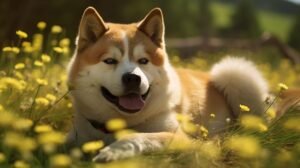Did you know that the Akita breed comes from a lineage of teddy bear-like Japanese dogs who were revered so much in Japan that only the imperial family and their court members could own them? So why is it that this fluffy and stately breed often leaves a trail of hair in its wake?
While you may stride down the street with an Akita and receive many admiring looks due to their stunning appearance, behind closed doors, they are constantly leaving bits and bobs behind them… of their fur. It’s a battle against the fur that any Akita parent knows all too well! Akitas sheds – not just ‘a bit’ or ‘moderately’ – but a lot and consistently. These fragments of fur seems to turn up in every nook and cranny in your house that you probably didn’t know existed.
But what’s the science behind this constant shedding, and are there any measures Akita owners can take to keep the hair blizzard in check? To answer those questions, we’ll first take a detailed look at their coats, understand the shedding cycle, discuss diet and health factors contributing to shedding, and finally, suggest some expert-approved tips to manage the shedding.
The Akita breed boasts a dual coat, consisting of a straight and harsh outer coat, and a soft and dense undercoat. The outer coat is a bit longer and visibly harsh, protecting the Akita from external climatic conditions. The undercoat, on the other hand, acts as a thermal fence, keeping the cold out and the warmth in. As seasons change and temperatures fluctuate, Akitas lose their undercoat, also known as “blowing the coat,” which results in substantial hair loss twice a year. The amount of fur that Akitas shed during these times often surprises new owners. Some may joke about it appearing like there’s enough fallen hair to stuff a small pillow or to form an entire new puppy!
Surprisingly, Akitas shedding are not limited to these periods. While it is less severe than the blowouts, the Akita dog maintains a steady shedding throughout the year. The shedding frequency can also be affected by other factors such as diet, health, stress and reproductive status. An unbalanced diet can lead to increased shedding. High fat diets stimulate hair growth and, consequently, shedding. Similarly, a lack of protein can impact the quality of an Akita’s coat leading to an increase in shedding as well.
Health conditions can also lead to Akitas shedding more than normal. Dogs may shed excessively due to food allergies or due to external parasites like fleas and ticks. A quick visit to the vet can help diagnose any health-related issues in your Akita. From there, you and your vet can decide on the best course of action to remedy the situation.
Before you despair, thinking of all the countless hours you would spend on cleaning up after your shedding Akita, let me tell you that there are silver linings. First, Akitas have an extremely high grooming instinct. They often lick and clean themselves, similar to cats, reducing the bulk of fur you have to deal with, although not completely eliminating it.
Secondly, regular brushing can drastically reduce the amount of shedding in the home. Utilizing the right tools – like a heavy-duty deshedding tool or a slicker brush – at least three times a week will do wonders. While it might sound like a hassle, getting into the habit of brushing your Akita down can turn into quality bonding time between you and your fluffy friend.
Akitas shedding, although they may seem like a tiresome characteristic to deal with for some, is an essential part of the dog’s natural coat cycle. Yet it should never dissuade you from opening your home and heart to these regal, loyal, and intelligent dogs. With proper knowledge, effective grooming, dietary care, and some love, you can embrace everything this unique breed has to offer without grumbling each time you see the floor carpeted with fur.
Regardless of the amount of shedding, Akitas hold a special place in the hearts of those who’ve had the privilege of knowing this breed. And if you ask any Akita owner, they’ll tell you confidently, every strand of fur is worth the unconditional love and companionship these noble dogs bring into our lives.



